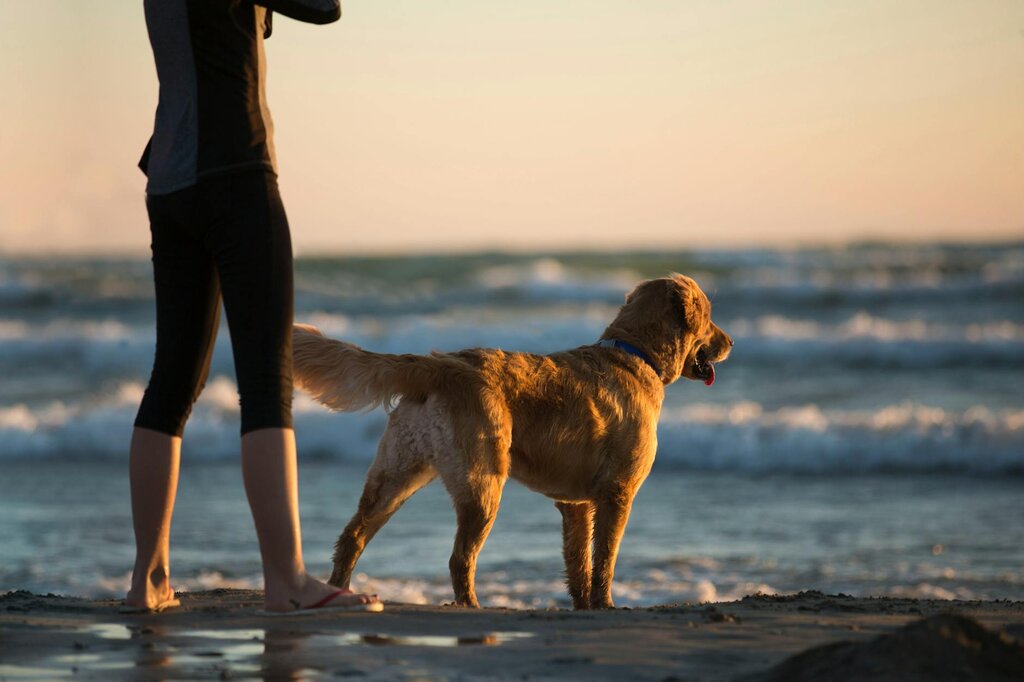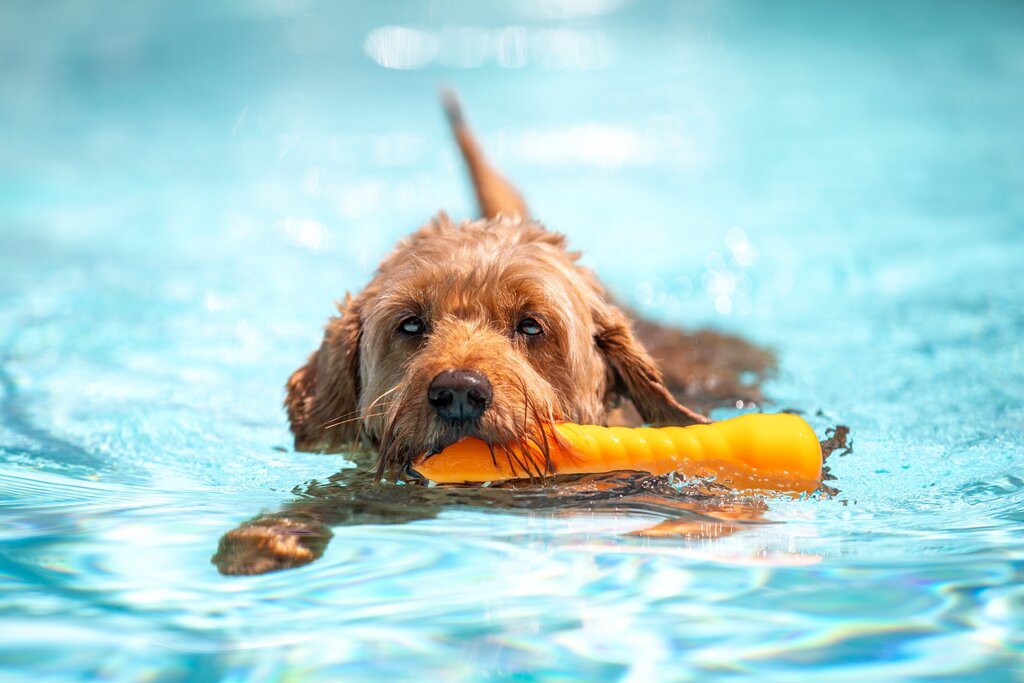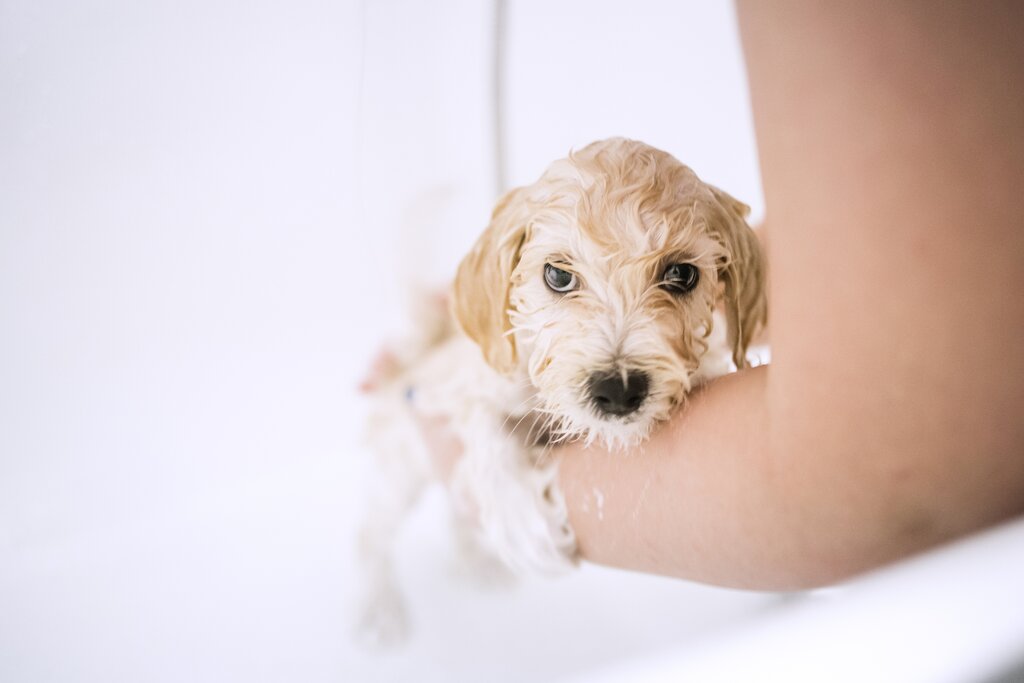Last Updated: 22/10/2025
Swimming Safety for Dogs
Is your dog keen to get in the water this Summer? Check out the important things you should know if your dog loves swimming.
Author: Dr Katelyn Bailey BVSc (Hons)
Reading Time: 10 minutes - short read
Swimming is a popular activity for dogs all around Australia, and for good reason - we're lucky enough to have a great climate and plenty of coastline to enjoy. Even if your dog doesn't have easy access to any of our beautiful beaches, they can still explore other waterways like lakes, rivers, dams and swimming pools.
While swimming is a great form of exercise, especially for dogs with joint problems or those needing to lose weight, there are a few important things to be aware of before taking your pooch for a dip.
Should you take your dog swimming?

First of all, it's worth considering whether your dog will actually enjoy and benefit from swimming.
While a preference for water can be dog-dependent, and some won't ever want to get a paw wet, certain breeds are difficult to keep out of the water! This includes working breeds like the Border Collie, the Golden Retriever and other Retrievers, and (unsurprisingly) breeds named for their love of water such as the Portuguese Water Dog and Irish Water Spaniel.
As far as the benefits go, swimming is very beneficial for most dogs, particularly those that suffer from joint or weight issues. A type of 'natural' hydrotherapy, it offers a low impact form of exercise that even young, healthy dogs can benefit from. It also provides some variety in your pup's routine and acts as an immersive and adventurous source of enrichment!
Brachycephalic (short-nosed) and chondrodystrophic (long-bodied) breeds like Pugs and Dachshunds are not as naturally gifted at swimming due to their anatomy and it's advised to use caution if allowing these breeds to swim. Long-bodied dogs can struggle in deep water and strong tides, and short-snouted breeds tire easily and are at increased risk of aspirating water due to their shortened airways.
While there is some instinct involved in developing swimming ability, it's still important to provide a gradual introduction to the water, ideally starting with a shallow dog pool or similar.
Read more in our article Teach Your Dog to Enjoy Swimming
Preparing for swim time
Before jumping in the water there are a few things to consider and prepare in advance.
Choosing a safe location
When possible, scouting out a new swimming spot before taking your dog there for the first time is recommended. Things like water depth and quality, local wildlife (including marine life) and overall safety are always important to consider. Strong recall skills are a great thing to develop particularly in busier or less predictable areas. Avoid beaches with strong tides or rips, waterways with visible debris or algae blooms, and of course national parks and other non dog friendly areas.
It's always important to supervise your dog while they're swimming, no matter how confident they seem in the water. Even the most experienced, water-loving dog can be caught off-guard by strong waves, rips, a new location, or inclement weather. Similarly, ensuring your pup can't access bodies of water, including pools, when unsupervised is vital.
Essential gear and swim toys
Before heading out for a splash, it’s worth being prepared with the right equipment to help keep your dog safe and having fun.
Life jackets: Even confident swimmers can tire quickly or be caught in unexpected currents. A well-fitted canine life jacket offers extra buoyancy and peace of mind — especially for beginners, senior dogs, or breeds with short legs or heavy builds.
Floating toys: Lightweight, waterproof toys that stay visible on the water’s surface are perfect for a game of fetch or tug. Look for toys made from buoyant materials that are easy for your dog to grip and carry.
Leads and harnesses: In areas with strong currents, unknown depths, or shared spaces, a long-line lead and secure harness can help you guide and control your dog safely without restricting their movement.
With a few smart accessories, your dog’s swim session can be both exciting and safe — the perfect way to beat the summer heat together.
Sun and heat safety

Just like us, sunburn is a concern for Australian pets thanks to high levels of UV radiation. Sunlight reflecting off water can worsen sunburn, so it's best to shorten your dog's swimming session if it's during the warmest part of the day, especially in summer. UV resistant sunsuits are available for pets particularly prone to sunburn, otherwise dog-safe sunscreen can be applied to at-risk areas like the ears, nose and belly. You should avoid using human sunscreens as they contain ingredients that are unsuitable for a dog's skin, and may be toxic.
Always bring a bowl of clean drinking water or water bottle and set up in a shaded spot to help your dog cool off and avoid drinking from unsafe sources.
Heat stroke is also a concern, so watching for signs of overheating during or after exercise is important. Signs to watch for include excessive panting, drooling, vomiting, collapse and gum discolouration. Long-haired, dark-coloured, brachycephalic, and overweight dogs are at higher risk of developing heatstroke.
Read more about summer care in our article Get Your Pet Summer Ready
Water-related health risks
For some dogs, it's not enough to just immerse their body in water - they also need to have a good taste of whatever it is that they're swimming in! Although this may seem innocent, drinking anything except for clean, fresh water can pose a serious health risk. Please note that swallowing a bit of water while swimming is almost inevitable, and is very unlikely to have any ill effects. Active drinking of the water, however, should be discouraged.
Water-toxicity risks
Salt water: Just like in humans, consumption of salt water in dogs can lead to salt toxicity, or hypernatraemia. The excess salt draws water out of the body's cells and into the circulation, creating a potentially deadly electrolyte imbalance. While a mild salt toxicity may only result in some diarrhoea or vomiting, a more severe case can cause extreme dehydration, muscle tremors, seizures, kidney damage, and even death.
Sandy water: A small amount of sand ingestion is unlikely to cause anything more than a mild tummy upset. Unfortunately some dogs develop a taste for sand and put themselves at risk of sand impaction, which is an intestinal blockage caused by a build-up of sand in the gastrointestinal tract. This can make your dog very ill and usually requires surgery to fix. Signs of sand impaction include vomiting, loss of appetite, abdominal pain and lethargy.
Chlorinated water: While the chlorine level in the average pool is generally quite low and safe for dogs to consume in small amounts, too much chlorinated water can lead to vomiting, diarrhoea and oesophageal irritation. High concentrations of chlorine (eg. in an improperly maintained pool) are toxic and can prove fatal.
Dam/river water: Stagnant, dirty or slow-moving water in a pond, dam or river may contain a range of nasty organisms including bacteria, parasites such as Giardia, or toxins like blue-green algae. If ingested, many of these can make your dog very unwell and may cause death. Some organisms, like Giardia, are zoonotic and can be passed from affected dogs to humans. It's recommended to avoid any water that appears dirty or stagnant especially in the warmer months.
It's best to not let your dog drink anything except clean, fresh water provided by you. If your dog is showing any concerning signs after ingesting other sources of water, it is important to take them to a vet as soon as possible.
Signs of blue-green algae toxicity include:
- Tremoring/shaking
- Seizures
- Excessive drooling
- Breathing difficulties
- Diarrhoea
- Vomiting
Signs of Giardia infection include:
- Watery diarrhoea
- Weight loss
- Abdominal pain
- Vomiting
Fish and marine life risks
While your dog might want to touch noses with any creature they come across, those creatures may not want to return the favour! With Australia's beautiful beaches come some dangerous marine critters that it's important to be aware of. While it's advised not to let your dog near any wildlife or marine animals, there are some that can cause a lot of harm and should be avoided at all costs. Inspecting beaches for bluebottles, puffer fish or other hazards before letting your dog off-leash is strongly recommended.
Blue Bottles: Blue bottle jellyfish can be found along any coastline of Australia and are most commonly washed ashore during strong winds. Even out of the water, they can still retain their ability to sting. Dogs that are stung by bluebottles (usually in the mouth or throat after attempting to eat them) can experience pain, excessive drooling and vomiting. In severe cases, swelling of the throat or even anaphylaxis can occur. If you suspect your dog has been in contact with a blue bottle (or any other type of jellyfish) it's best to get them examined by a vet as soon as you can.
Pufferfish and Toadfish: These species contain an extremely powerful neurotoxin in their skin and organs that causes vomiting, drooling, trembling, breathing difficulties, paralysis and even death if eaten, chewed or licked. They are often found along the shoreline or in shallow water. This toxin is fast-acting and very potent (approximately 1200 times more toxic than cyanide) so if your dog is exposed, even if they're not yet showing signs, you should take them to a veterinarian immediately where symptomatic treatment can be commenced.
Fishing equipment
Fishing equipment is another common hazard, particularly around waterways used for fishing.
Fish hooks may be left lying on shores or jetties or left embedded in dead fish, and their fishy odour makes them very attractive to a lot of dogs. Fish hooks can cause all sorts of injuries when swallowed, including puncture of the oesophagus, windpipe or stomach, as well as injuries to the lips, gums and throat. They may also become embedded in other areas of the body, most commonly the paw. If you suspect your dog has come in contact with a fish hook, or even if you can see the fish hook stuck, it's important to keep them calm and transport them to a vet clinic as soon as possible. It is not recommended to attempt to remove the hook yourself as this can lead to further damage and/or worsen bleeding. In most cases sedation will be needed to remove the hook, and if it has been swallowed, surgery may be required.
Hooks aren't the only things that can be dangerous if eaten. Fishing line can entangle in the intestines, causing a blockage. Fishing weights, or sinkers, can also cause an obstruction- and those that are made out of lead are toxic, which results in a delayed lead toxicity as the coating is gradually dissolved by stomach acids.
If you are concerned your dog may have swallowed something they shouldn't, whether it's a hook, line, sinker, or something else entirely, it's best to get them checked by a vet.
Post-swim care

Ear care
Not surprisingly, swimming almost inevitably leads to water getting down the ears. Increased moisture in the sensitive environment of an ear canal has the potential to develop into an ear infection. We recommend using a gentle, non-irritant ear cleaner after your dog goes swimming, ideally one formulated to dry out the ear canal and reduce the risk of any infection developing.
Common signs that your dog may have an ear infection include regular head shaking, ear scratching, or increased ear-related pain, odour or discharge. Where possible, try to prevent your dog from putting their head underwater for prolonged periods, and never splash water directly into their ears.
Skin care
Having an excitable wet dog that takes a long time to dry can be frustrating, but did you know that a damp coat can also pose a health hazard for your pup? A coat that is wet for a prolonged period traps water near the skin and this can develop into a localised skin infection, known as moist dermatitis or a hot spot. This area of rapidly growing infection can become a much larger, moist, oozing wound very quickly. While this is more common in dogs with long or thick coats, or in pets with existing allergies, short-haired dogs can also be affected. For at-risk dogs we recommend sticking to morning swim sessions so their fur has adequate time to dry before nightfall, and for dogs that suffer recurrent hot spots it may be necessary to avoid swimming entirely in the cooler months. You can also consider a thorough towel dry, or even a blow dry, after swimming.
Please note: if you're concerned your pet may have a hot spot, a visit to your vet is strongly recommended. The hair in the affected area may need to be clipped, and antibiotics and pain relief can be prescribed. Left untreated, the infection can continue to spread.
If your dog swims in a sandy or muddy environment, you may need to bathe them more regularly. Many shampoos can dry your dog's skin out if you use them too often, so I recommend a gentle, moisturising oatmeal-based shampoo.
Swimming is a fantastic form of exercise and enrichment that many dogs absolutely love, and it's also a great way for you and your pooch to enjoy Australia's climate. While there are some potential dangers, following the above tips will help ensure a safe, playful and most importantly fun time for your pup.
Articles recommended for you
Our vet authored guide to the benefits of feeding your dog fresh food plus tips and advice for introducing it into their regular menu.
See our guide to protecting your pet from parasites from our vet team.
Thinking of getting a fish? Check out our guide for setting up a tank and home care tips!
Looking to understand horse feeds better? This comprehensive guide covers feeding recommendations for horses of all ages and disciplines.
Does your pet suffer from anxiety? Check out our Vet-guide for treatment options to help your pet.
History
Our experts continually monitor the health and wellness space and we update our articles when new information becomes available.
Wed Oct 22 2025
Edited by Dr Belinda Stancombe BVSc (Hons)Dr Belinda Stancombe BVSc (Hons)
Veterinarian
Dr Belinda graduated from The University of Queensland in 2009 and has worked as a Small Animal Veterinarian for over 10 years in South East Queensland. She also has experience as a telehealh consultant, providing veterinary advice for online customers.She has a special interest in animal behaviour, preventative health, the human-animal bond and internal medicine. Outside of work hours she is closely affiliated with a kitten rescue and is also a devoted carer of orphaned rescue kittens.

